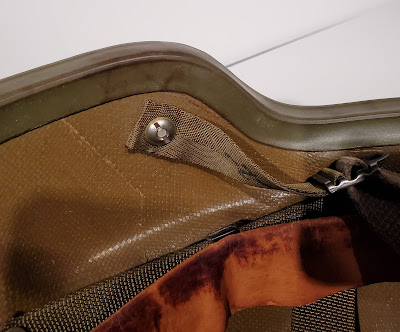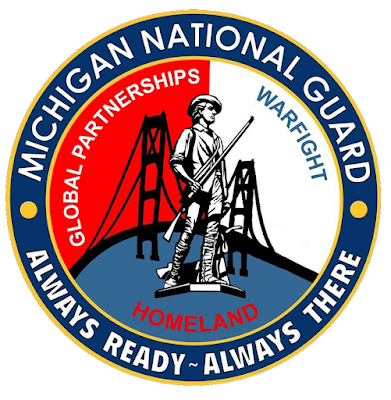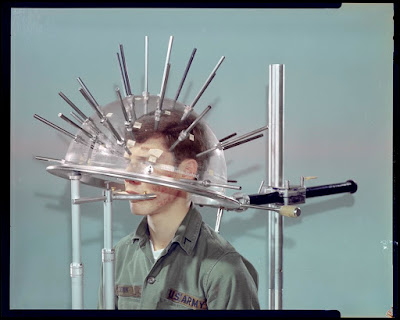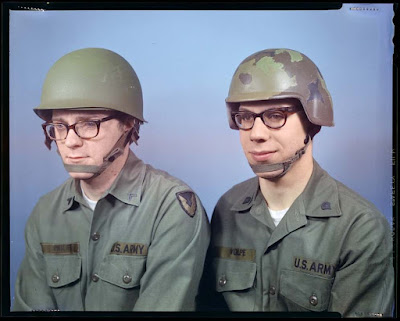This is a continuation of my previous post on the PASGT helmet. Rather than repeat all of that information, kindly go to: https://combathelmets.blogspot.com/2024/06/united-states-pasgt-combat-helmet.html for the complete rundown of another PASGT helmet from my collection.
In 1985 I was working as a graphic artist at a typesetting company in Grand Rapids Michigan. One of my colleagues, Randy, was a sergeant in the Michigan National Guard.
Randy asked me to design a Tee-shirt for his unit. When price was discussed, I told him that instead of money, I'd like one of the new Kevlar helmets which had only just been issued to his unit. He gave me the look of someone who knew that he was being hoodwinked, but he reluctantly agreed. He got the Tee-shirt and I got the helmet; the helmet featured in this post.
Thanks Sergeant Randy.
The US military phased out the steel helmet and opted for a whole new concept in helmet design - ballistic composite resin-saturated Aramid fiber compressed under heat and pressure. This was to be the first composite helmet to enter the world stage.
Where the M1 consisted of two pieces - the helmet and helmet-shaped liner, the PASGT helmet was a one piece. Although the new helmet provided superior protection, it wasn't as versatile as the M1, which, because of its removable liner, could be used as a bucket, a wash basin, a shovel, as well as other handy uses. Many a WWII GI dug his foxhole or soaked his feet with an M1 shell.
The PASGT was commonly called the "Fritz" because of its resemblance to the German helmet of world wars I and II.
Helmets were issued with the "woodland" pattern camouflage cover; this was in the days prior to the US military engaged in desert operations, and was more suitable for Cold War operations against the Soviets.
The rear of the foliage band included two glow-in-the-dark "cat's eyes" allowing soldiers to keep track of each other in darkness.
A hold-over from the M1 is the familiar Riddell suspension system.
As with previous US helmet models, the PASGT has a textured non-reflective surface finish.
The bulges in the sides of the helmet provided clearance for communications handsets.
The headband size was adjustable with a sliding buckle.
The DLA number indicates that this particular helmet was contracted in 1983 - very early in the production run of the PASGT helmet.
As with all American helmets, the webbing and furniture are robust and well-made.
The rim is bound with rubber edging.
Another hold-over from the M1 - though much-modified - are the "A" washers which affix the suspension to the shell.
The chinstrap includes a rudimentary chin-cup.
A final remnant from the old M1 are the metal spring-clips which secure the headband to the suspension. The purpose of the little loop is unknown to me. Perhaps a reader could leave a comment of explanation.
These helmets were issued in sizes extra small to extra large, with fifty percent of the production being size medium.
The PASGT soldiered on for about twenty years before the Army and Marine Corps adopted a newer helmet with a slightly different, and improved, design. The PASGT is still found in the US Navy as well as many reserve units,
Thanks to Sergeant Randy for "appropriating" this helmet from the Michigan National Guard. I hope he didn't end up in Leavenworth prison.
Stay tuned for the third and final installment of the PASGT helmet story featuring another cool helmet from the collection. Until next time...
Mannie
(Again, for more photos of another PASGT, as well as the full story of its development, kindly go to my previous post from a few days ago: https://combathelmets.blogspot.com/2024/06/united-states-pasgt-combat-helmet.html)
Sources
Brayley, Martin J., Tin Hats to Composite Helmets: a collectors guide. The Crowood Press, 2008.
Military One Source, Military Installations, https://installations.militaryonesource.mil/in-depth-overview/natick-
Yonggiang, Li, Science Direct vol 238, June 1, 2022, Ballistic helmets: Recent advances in materials, protection mechanisms, performance, and head injury mitigation. https://www.sciencedirect.com/science/article/abs/pii/S1359836822002694#preview-section-references
U.S. Army, USAG Natick, https://home.army.mil/natick/my-fort/newcomers
Digital Commonwealth, Massachusetts Collections Online, PASGT helmet development, https://www.digitalcommonwealth.org/search?page=8&q=PASGT+helmet+development&search_field=all_fields
Reynosa, Mark A., (PASGT) Helmet: an Illustrated Study of the U.S. Military's Current Issue Helmet. Schiffer Military History, 1999.
Reynosa, Mark A., U.S.Combat Helmets of the 20th Century. Schiffer Military History Books, 1997.
Army Navy Warehouse, Using Contract Numbers to Determine Dates on Military Gear, July 7, 2020. https://www.armynavywarehouse.com/post/contract-number-dating
Camopedia, United States, https://www.camopedia.org/index.php/USA














































.png)




.heic)








.png)









.png)